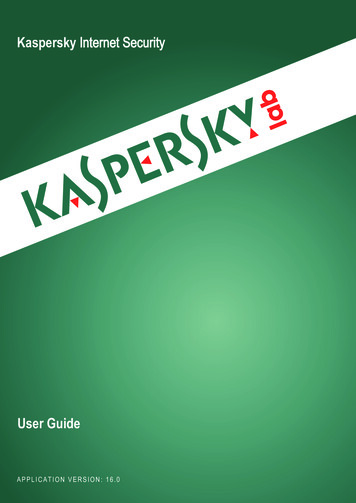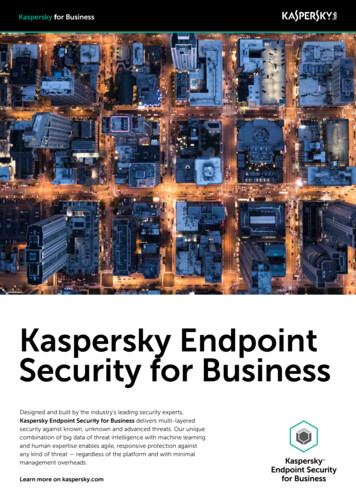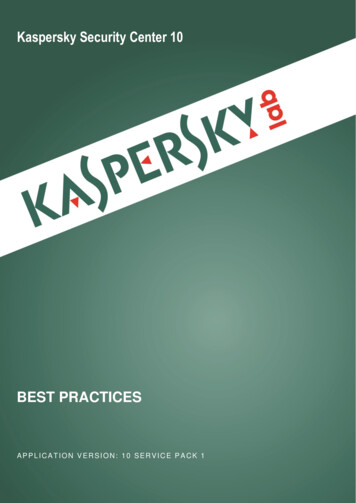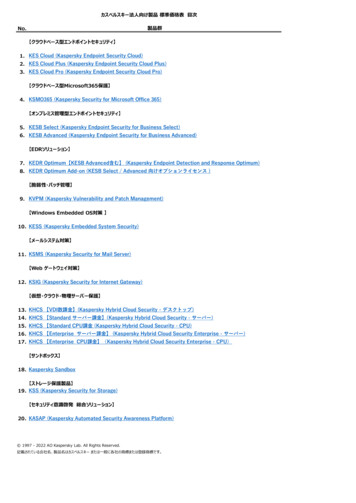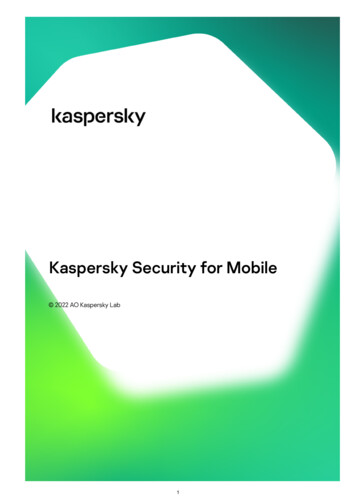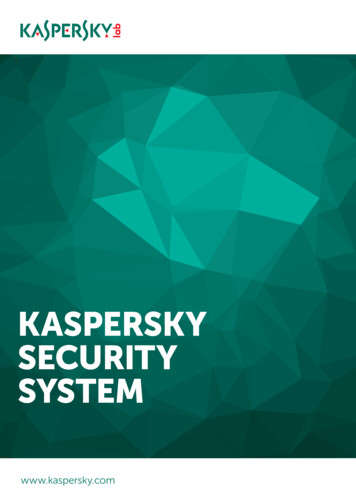
Transcription
KASPERSKYSECURITYSYSTEMwww.kaspersky.com
Kaspersky Security SystemINTRODUCTIONNowadays all computer systems, including cyber-physical systems used in criticalinfrastructure, are prone to many cyberthreats. These computer systems are oftenprotected by add-on tools that are incapable of addressing their specific securityrequirements. Such security tools don’t have adequate means of defining the appropriatesecurity policy for every system or for enforcing these policies exactly as defined.For this reason Kaspersky Lab has created an embeddable solution that meets currentsecurity requirements. Kaspersky Security System is an innovative framework that isintended to secure a wide range of computer systems such as: Enterprise systems Special-purpose computer systems The Internet of Things Smart grids Industrial systems Transportation systems Critical InfrastructureADVANTAGES T he Kaspersky Security System paradigm is based on the strict separation of securityfeatures from the functional components of the computer system. Security isprovided regardless of how the system is implemented. Because of this, trustedsystems can be built using untrusted components and KSS. Security rules and policiescan be varied without changing any functional components. Kaspersky Security System allows for the combination of different security models,such as connecting basic and specific security policies. Under some special conditions Kaspersky Security System can be used in real-timeoperating systems. The architecture of Kaspersky Security System enables the definition of specificsecurity rules for every given system and excludes unnecessary controls andcomplicated configurations from the overall solutionHISTORYKaspersky Lab is creating a portfolio of security solutions for critical infrastructure aspart of a global initiative. One of these solutions is KasperskyOS, the secure operatingsystem. KasperskyOS was developed using the best design practices and de-factosecurity standards. Adherence to these practices and standards will better assure theconfidentiality and integrity of the data in the computer system.Kaspersky Security System was initially implemented as a part of KasperskyOS with aview to supporting diverse security models. But during development it became clearthat Kaspersky Security System fits the needs of many other operating systems andhypervisor-based solutions. As a result, it has evolved into a stand-alone project and cannow be embedded into other systems that demand high security levels.3
4Kaspersky Security SystemKaspersky Security SystemIMPLEMENTATIONCOMPONENTSKaspersky Security System is implemented as an OEM component for operating systemor hypervisor-based solutions. S ecurity Runtime is the module that enables the interaction between the existingsystem’s internal components and Kaspersky Security System. It delivers every requestto the security verdict engine and returns the computed verdict to the system.TARGET AUDIENCE V endors of operating systems and hypervisor-based solutions V endors of IT systems demanding enhanced security levels System integrators S ecurity Server is the security engine that computes the security verdict (whether aninteraction should be permitted or not). It provides its verdict using the following factors:– The set of security rules implemented in the security policy for the system.– The security context that describes the current state of the system.MAIN FEATURES C onfiguration tools are used to adjust security policies and rules and deploy them inthe system. A pplying access control rules based on the separation of security domainsA djusting the interaction of components related to different security domainsC lassifying informational resources according to a given security policyC omputing the security verdict to authorize every action in the systemS ecurity logging and auditP roviding additional security servicesInformation SystemDomain 0INTEGRATIONThe integration of Kaspersky Security System into the initial operating system or solutioncan be undertaken in two phases:Stage 1. Pre-project phase1. A nalyzing the existing solution (operating system or hypervisor-based solution,special hardware aspects).2. Defining a plan to adapt Kaspersky Security System to the existing solution.3. Creating the appropriate security policies.Stage 2. Integration phase4. I ntegrating Kaspersky Security System into the existing system.5. Deploying the security policies.Domain 1Kaspersky Security SystemSecurityRuntimeSecurityServerConfiguration toolsDomain 2Figure 1. An example of Kaspersky Security System managing three security domains of an InformationSystem under a single security policy. The part of Kaspersky Security System, Security Runtime, mediatescommunications between security domains and enforces predefined security rules which are set byConfiguration tools. Security Server includes a customizable database of security policies and providesdecisions to Security Runtime based on the current state of the system.OPERATING MODESThere are two operating modes for Kaspersky Security System: T he basic mode includes a wide range of security policies, sufficient for most usagescenarios. T he customized mode builds on the basic mode with special security policies necessaryto comply with the specific objectives of the target solution.5
6Kaspersky Security SystemCOMPATIBILITY*Kaspersky Security System is now available for the following operating systems: K asperskyOS** P ikeOS L inuxSUPPORTING DOCUMENTATIONThe supporting documentation includes a set of design patterns, best practices for softwaredevelopment, and configuration rules to help achieve the highest levels of security.PATENTSThe technologies that form the basis of Kaspersky Security System and Kaspersky OSare covered by a set of patents:US 7386885 B1, US 7730535 B1, US 8370918 B1, EP 2575318 A1, US 8522008 B2,US 20130333018 A1, US 8381282 B1, EP 2575317 A1, US 8370922 B1, EP 2575319 A1.* Work on providing support for other operating systems, including some real-time OS, is in progress.** T he deep integration of KasperskyOS and Kaspersky Security System creates a sustainable, versatile and high performance platform to supportsecurity in different systems, including industrial networks.
2016 AO Kaspersky Lab. All rights reserved. Registered trademarks and service marksare the property of their respective owners.AO Kaspersky Lab, 39A/2 Leningradskoe shosse, Moscow, 125212, Russian Federation,info@kaspersky.com, www.kaspersky.com
2. Defining a plan to adapt Kaspersky Security System to the existing solution. 3. Creating the appropriate security policies. Stage 2. Integration phase 4. Integrating Kaspersky Security System into the existing system. 5. Deploying the security policies. Figure 1. An example of Kaspersky Security System managing three security domains of an .

![Kaspersky Antivirus 6.0.4.1424. Key File 18 [REPACK]](/img/59/maramon.jpg)



![Kaspersky Password Manager 9.0.1.447 Crack [BETTER]](/img/55/kaspersky-password-manager-901447-crack-better.jpg)
